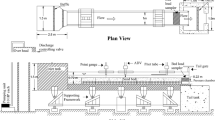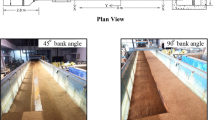Abstract
Recently the international trend of water management is changing from the supply to the demand management, shifting the paradigm of the water resource control. As a result, the Smart Water Grid as the next generation system is being studied and developed in many countries. Although many researchers have kept an eye on the system, the very important discharge estimation in a river is still in question. In many countries, the stage-discharge curve method has been used to predict discharge at a low or high stage in spite of its uncertainties. In order to improve the conventional problem, in the current study, the authors developed a new mean velocity estimation law reflecting hydraulic characteristics such as the bed slope, width, wetted perimeter, kinematic viscosity and etc. The proposed method is possible to estimate the maximum velocity which is difficult to measure in an open channel, and the reliable flow rate estimation is also possible by calculating the entropy function called “Equilibrium state phi (M)” which presents a specific character of a river. The results present remarkable precision and show that the accurate estimation of discharge is possible at flood season.
Similar content being viewed by others
References
Chaudhry, H. M., Smith, K. V. H., and Vigil, H. (1970). “Computation of sediment transport in irrigation canals.” Institution of Civil Engineers, Vol. 45, pp. 79–101.
Chiu, C. L. (1978). “Three-dimensional open channel flow.” J. Hydraulic Division, ASCE, Vol. 104, No. 8, pp. 1119–1136.
Chiu, C. L. (1987). “Entropy and probability concepts in hydraulics.” J. Hydraulic Engineering, ASCE, Vol. 113, No. 5, pp. 583–599.
Chiu, C. L. (1988). “Entropy and 2-D velocity distribution in open channels.” J. Hydraulic Engineering, ASCE, Vol. 114, No. 10, pp. 738–756.
Chiu, C. L. (1989). “Velocity distribution in open channel flow.” J. Hydraulic Engineering, ASCE, Vol. 115, No. 5, pp. 576–594.
Chiu, C. L. and Chen, Y. C. (2002). “An efficient method of discharge measurement in tidal streams.” J. Hydrology, Vol. 265, pp. 212–224.
Chiu, C. L. and Said, C. A. A. (1995). “Maximum and mean velocities and entropy in open channel flow.” J. Hydraulic Engineering, ASCE, Vol. 121, No. 1, pp. 26–35.
Chiu, C. L. and Tung, N. C. (2002). “Maximum and regularities in open-channel flow.” J. Hydraulic Engineering, ASCE, Vol. 128, No. 4, pp. 390–398.
Choo, T. H. (1990). Estimation of energy and momentum coefficient in open channel flow by Chiu’s velocity distribution equation, MSc Thesis, University of Pittsburgh, Pittsburgh.
Choo, T. H. (2002). “A method of discharge measurement using the eEntropy concept (1) — based on the maximum velocity.” J. of the Korean Society of Civil Engineers, KSCE, Vol. 22, No. 4B, pp. 495–505 (in Korean).
Choo, T. H., Kim, C. M., Ha, G. B., and Yoon, H. C. (2011) “Estimation of discharge adapting changes of river environment.” Korean Society of Hazard Mitigation, Vol. 11, No. 5, pp. 241–246.
Choo, T. H., Lee, S. J., Park. S. W., and Oh, R. S. (2009a) “Estimation of river discharge by probabilistic velocity function considering hydraulic characteristics.” Journal of Korea Water Resources Association, Vol. 29, No. 6B, pp. 537–542.
Choo, T. H., Maeng, S. J., Yoon, H. C., Kim, D. M., and Kim, S. C. (2012). “A study on the derivation of a mean velocity formula from Chiu’s velocity formula and bottom shear stress.” International Journal of Environmental Research, Vol. 6, No. 2, pp. 537–546.
Choo, T. H., Ok, C. Y., Kim, J. W., and Maeng, S. J. (2009b). “A study on the velocity distribution in closed conduit by using the entropy concept.” Journal of Korean Society of Civil Engineers, KSCE, Vol. 29, No. 4B, pp. 357–363 (in Korean).
Cunge, J. A., Holly, F. M., jr., and Verway A. (1980). Practical aspects of computational river hydraulics, Pitman, Boston, Mass, USA.
Guerrero, J.-L., Westerberg, I. K., Halldin, S., Xu, C.-Y. and Lundin, L.-C. (2012). “Temporal variability in stage-discharge relationships.” J. Hyrology, Vol. 446–447, pp. 90–102.
Jalbert, J., Mathevet, T., and Favre, A.-C. (2011). “Temporal uncertainty estimation of discharges from rating curves using a variographic analysis.” J. Hydrology, Vol. 397, pp. 83–92.
Kalkanis, G. (1957). Turbulent flow near an oscillating wall, California Univ., Berkeley Wave Research Lab, Technical Memo, AD0158751.
Khatibi, R., Sivakumar, B., Ghorbani, M. A., Kisi, O., and Kocak, K. (2012). “Investingating chaos in river stage and discharge time series.” J. Hydrology, Vol. 414–415, pp. 108–117.
Leon, J. G., Calmant, S., Seyler, F., Bonnet, M.-P., Cauhopé, M., Frappart, F., Filizola N., and Fraizy, P. (2006). “Rating curves and estimation of average water depth at the upper Negro River based on satellite altimeter data and modeled discharges.” J. of Hydrology, Vol. 328, Nos. 3–4, pp. 481–496.
Oh, J. S., Kim, B. S., Kim, H. S., and Seoh, B. H. (2005). “An estimation technique of flood discharge.” J. of the Korean Society of Civil Engineers, KSCE, Vol. 25, No. 3B, pp. 207–213 (in Korean).
Paintal, A. S. (1971). “Concept of critical shear stress in loose boundary open channels.” J. Hydraulic Research, Vol. 1, pp. 90–113.
Ronald A. B. (2009). National smart water grid, Lawrence Livermore National Laboratory, LLNL-TR-414794.
Sahoo, G. B. and Ray, C. (2006). “Flow forecasting for a Hawaii stream using rating curves and neural networks.” J. of Hydrology, Vol. 317, Nos. 1–2, pp. 63–80.
Simons, D. B. (1957). Theory of design of stable channels in alluvial materials, PhD Thesis, Colorado State University.
US Army Corps of Engineers WaterWays Experiment Station (1936). Flume tests made to develop a synthetic sand which will not form ripples when used in movable-bed models, Technical Memorandum 99-1 (unpublished), Vicksburg, Mississippi.
US Bureau of Reclamation (1958). Interim report, Total Sediment Transport Program, Lower Colorado River Basin.
Vanoni, V. A. and Brooks, N. H. (1957). Laboratory studies of the roughness and suspended load of alluvial streams, M.R.D. Sediment Series Laboratory.
Author information
Authors and Affiliations
Corresponding author
Rights and permissions
About this article
Cite this article
Choo, T., Yoon, H. & Maeng, S. An element technique development reflecting the entropy concept of the application to smart water grid. KSCE J Civ Eng 18, 294–303 (2014). https://doi.org/10.1007/s12205-013-1111-5
Received:
Revised:
Accepted:
Published:
Issue Date:
DOI: https://doi.org/10.1007/s12205-013-1111-5




